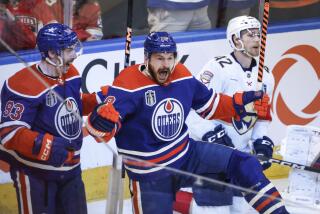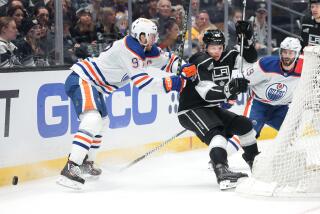Oilers’ Coffey Is Whiz in Bobby Orr Mold
- Share via
EDMONTON, Canada — With each rush down the ice, Paul Coffey is looking more and more like Bobby Orr, the most famous defenseman ever in the NHL.
And in part, Coffey has one of the league’s all-time least known defenseman to thank.
Journeyman defenseman Gary Lariviere scored only once in 95 games with the Edmonton Oilers. In fact, he had but six goals in 219 games in the NHL. He rode the bench for all but 17 games of the 1982-83 season and for the past two seasons was mired in the minors on hockey’s milk run.
But Lariviere, in his own way, is barreling into the record books. The scoring summaries won’t bear his name, but without Lariviere’s influence, any challenge by Coffey to Orr’s sacred turf might still be fantasy.
“I still remember one practice early in my first year in 1980-81, (Oilers Coach Glen) Sather had me on with Lariviere,” Coffey recalls. “Gary skated up to me and said, ‘Kid, I hear you got the good wheels. Any time you get the puck, go.’ That meant a lot to my confidence. Gary wasn’t with us for all that long, but I still think back to that advice.”
Coffey has been “going” ever since. When Lariviere said go, it was like lifting the brakes from a Corvette.
“I know skating is my strongest asset,” Coffey said. “Very seldom when I rush into the offensive end do I stop. I always keep moving so if I have to get back to the other end, I can usually catch people by our blueline.”
In the past two seasons, the freewheeling defenseman has scored 126 and 121 points--totals topped only by Orr in the history of NHL rearguards. Not surprisingly, comparisons between the two have started and Coffey is flattered. “It’s definitely an honor, a thrill to be compared to him,” Coffey confessed. “Even the smallest comparisons are nice. In my estimation, when Orr came into the league, he changed the style of defenses for the ‘70s and ‘80s.”
In 1969-70, Orr became the only defenseman ever to win the Art Ross Trophy as the league’s top scorer. He repeated the feat in 1974-75 and finished second to Boston teammate Phil Esposito three other times, including 1970-71 when Orr scored 139 points--a record for blueliners that still stands.
The similarities between Orr and Coffey are obvious: brilliant skaters and superb playmakers both, with devastating shots and most significantly, the ability to control the flow of play.
When Orr was in his prime, Coffey was a few years short of shaving -- hard to fathom now when the 24-year-old can grow a beard in two turns of a medium-speed Zamboni. It would be only too natural to assume that as a young hockey player in Toronto, Coffey patterned himself after the No. 1 son of Parry Sound, Ontario, just a few hours up the turnpike into Ontario’s cottage country. But that was not the case.
“When I was 16 or 17, my legs got stronger and I started rushing the puck, but I didn’t try to pattern myself after anyone,” Coffey said. “When you try to play like Bobby Orr, that’s when you get yourself in trouble. There were so many things he could do.
“Actually, our skating styles are a lot different. He had a lot better moves inside whereas I try to go outside and use my skating.”
Perhaps more striking than the similarity of their play, is that of their career patterns.
Both evolved out of the Ontario junior hockey breeding grounds and stepped right into the NHL, without any bus stops in hockey’s hinterlands. They played for teams that, not coincidentally, quickly became winners. They shared the spotlight with centers that at the time they played were the best in the game--Esposito and Wayne Gretzky. And most remarkably, both fought fan and media derision in their early years because of daring offensive styles that contrasted with the traditional stay-at-home defensemen who had ruled the NHL bluelines prior to Orr’s arrival.
One would have thought that so many seasons after Orr broke the mold, Coffey’s path would have been easier. Not so.
“I think the caliber of player he is, if he makes mistakes in his own end, it’s more noticed,” said Charlie Huddy, Coffey’s partner on defense for the past three years.
“They can’t knock his offense, so they knock his defense. But Paul works very hard in his own end, especially this year. I’m sure when he’s finished, they’ll forget their criticisms and only remember his point totals.”
However, Coffey is learning to take advantage of critics’ knocks. Last year after he finished second to a consummate traditional blueliner, Washington’s Rod Langway, in the Norris Trophy voting for the league’s top defenseman, it was reported he was irritated.
With the point registered, Coffey has not hammered it in this year and has been quite magnanimous about how the media voted last year.
More to Read
Go beyond the scoreboard
Get the latest on L.A.'s teams in the daily Sports Report newsletter.
You may occasionally receive promotional content from the Los Angeles Times.






